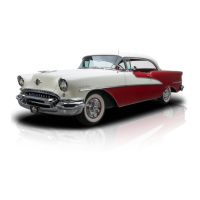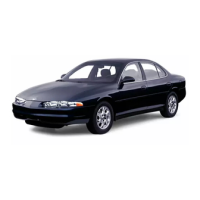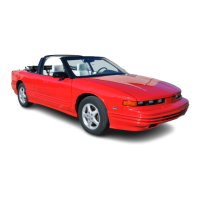20
MAINTENANCE
Even though designated
"For
Service
MS"
or
"For
Service
DG",
some com-
mercial
crankcase
oils
form
the
type
of
combustion
chamber
deposits
that
increase the
tendency
for
detonation
and
pre-ignition; also,
some
are defi-
cient
in
anti-wear
characteristics
and
so
may
contribute
to
rapid
wear
of
highly stressed engine parts, such as camshaft, valve lifters, rocker arms,
and
piston rings.
Under
adverse
operating
conditions
where a greater
concentration
of
addi-
tives
is
required, a High Detergency Concentrate which has been thoroughly
tested
and
·
recommended
is
available
from
your
Oldsmobile
dealer
under
General
Motors
Part
Number
564800.
The
use
of
proprietary
compounds,
such
as
"break-in"
oils,
"tune-up"
com-
pounds,
"tonics,"
"friction
reducing"
compounds,
etc.,
are
entirely
unnecessary
and
are
not
recommended
for
use
in
your
Rocket
engine.
VISCOSITY
SAE
viscosity
numbers
specify viscosity
only
and
should
not
be
confused
with
"Type
of
Oil."
The
lower viscosity
or
"thinner"
oils, such as SAE 5W
or
SAE
lOW
, are designed for use
during
cold weather to provide fast start-
ing
and
instant
lubrication
.
The
higher
viscosity
or
"thicker"
oils, such as
SAE
20W
or
SAE
20,
are
designed for
use
during
warm
or
hot
weather
to
provide
adequate
lubrication
and
satisfactory oil
consumption
under
higher
operating temperatures.
Several oil companies now
market
multiple viscosity oils, such as SAE 5W-20,
SAE
IOW-20,
SAE
IOW-30, etc.,
which
are
designed
to
combine
the
fast
starting
and
instant
lubrication
characteristics
of
the
lower
SAE
number
with the
warm
weather
operating
characteristics
of
the higher SAE number.
The
proper
oil viscosity to use
depends
upon
the
range
in
atmospheric tem-
perature
that
will be
encountered
during
the
period
the
oil
remains
in
the
crankcase.
More-than-normal
oil
consumption
will
be
encountered
during
warm
or
hot
weather,
particularly
under
high
speed
driving conditions,
if
the
oil viscosity is too low.
The
following
chart
will serve as a guide to the
proper
oil viscosity to use
under
various atmospheric temperature conditions.
It
is
not
necessary to
change
oil for the unseasonably cold
or
warm
dayen-
countered
during the fall
or
spring season.
NOTE:
For
your
protection,
the
SAE
viscosity
number
should
be
plainly
marked
on
the containers.

